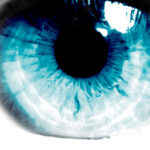Dandruff that affects the eyelids is a medical condition known as blepharitis. It is a bacterial condition that is a source of irritation to the eye. Normally, when people think of dandruff, they visualize white flakes along a collar line, but dandruff of the eyelid is different. It is a serious medical condition that should not go untreated. This condition that affects the eyelid will cause severe itching, redness, excessive tearing and may produce a burning sensation. It is referred to as a disease, and the more advanced forms may include a crusty buildup around the eyelid and lashes. Patients will also experience swelling and the feeling that there is something in the eye. The condition is not contagious, but does resemble symptoms of conjunctivitis.
There are two forms of this eyelid condition, seborrheic blepharitis and ulcerative blepharitis. Many people are familiar with the term seborrhea and relate it to conditions of the skin and scalp. This type of blepharitis appears as flakes around the base of the lashes combined with redness on the eyelid. The ulcerative type is not as common, but is more serious. Ulcerative blepharitis is characterized by hard crust around the lashes. When this crust is removed, it can cause small sores to appear that will ooze and bleed. Some patients may experience a loss of the eyelashes and excessive tearing in the affected eye. This type is much more serious because the cornea itself could also become inflamed and irritated.
Blepharitis can appear in one of two forms, anterior and posterior. The anterior form will affect the outer surface of the eyelid, usually where the eyelashes are attached. This form is commonly caused by bacteria. Posterior blepharitis will affect the inner part of the eyelid and is associated with acne rosacea and dandruff of the scalp. If you notice any irritation to the eyelid, contact a doctor, especially if there is a crusty buildup. Some immediate relief may be gained by applying a warm compress to the eye until you are able to see a doctor. Keep the area as clean as possible and always make sure to wash your hands before touching your eyes. It is important not to ignore this condition. If left untreated, a bacteria form may cause long-term effects. These could include dilated capillaries, eyelash loss, entropion and ectropion (the turning outward or inward of the eyelid) and thickened eyelid margins.
Blepharitis can be a difficult condition to manage. The condition is recurrent. The treatment will largely depend on what kind of blepharitis the patient has. Almost every treatment will include the use of a warm compress. This is used to loosen any crust that has formed before cleaning the eye. Keeping the eye clean is essential to a successful treatment. There are various ways to clean the affected area, including warm water rinses, salt water, baby shampoo that is diluted or an over-the-counter product that has been designed to clean the eyelids. When implementing a cleaning routine, be sure to never use the same cleaning materials more than once. This will spread the bacteria and will make the condition worse. Always use clean and new swabs or cloths when cleaning the eye. In some cases, an antibiotic may be prescribed, depending on the severity and type of blepharitis. This medication will be either oral or topical.
While treating this condition, refrain from using eye makeup and wearing contact lenses. If wearing contacts is a necessity, switch to a soft lens and change them more frequently. Failure to do so may result in a buildup inside the eye. Combinations of these treatments are often used. The exact treatment plan will depend on the extent and type of the condition. Maintain appointments with an eye doctor for follow up visits and monitoring of the condition.




